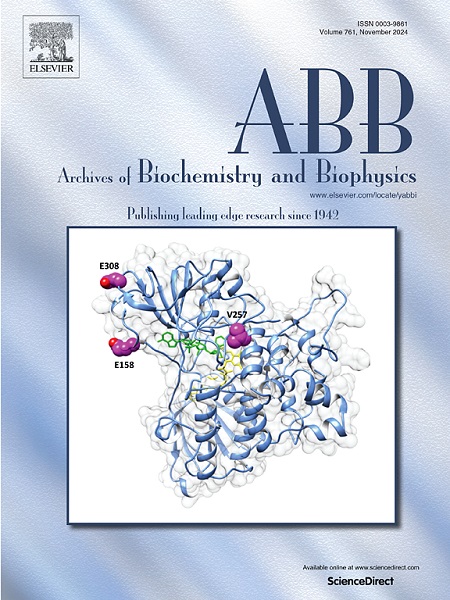p53寡聚化结构域的R337C突变影响调控结构域及其结合应答元件的能力:基于结构和生物物理研究的证据。
IF 3.8
3区 生物学
Q2 BIOCHEMISTRY & MOLECULAR BIOLOGY
引用次数: 0
摘要
同四聚体形式的p53对于维持基因组稳定性和防止不受控制的细胞增殖等基本功能至关重要。在某种程度上,这些关键功能是由p53 c -末端区域(CTR)介导的,该区域包含四聚/寡聚结构域(TD/OD)和调控结构域(RD),负责蛋白质的寡聚状态并调节p53功能。四聚结构域的突变降低了p53的转激活电位并改变了p53的转激活特异性。本研究探讨高频四聚错义突变p53R337C对蛋白质稳定性、寡聚状态及其结合DNA应答元件能力的影响。利用CD和FTIR光谱,我们首次发现p53调控结构域(363-393)和寡聚化结构域(327-355)具有典型的α螺旋二级结构,该结构域与DNA结合后增强,这意味着该结构域的稳定性。CD和DSC热研究表明,OD中R337C突变影响了p53 CTR的二级和三级结构,导致二级结构丢失,形成不稳定的四聚体。令人惊讶的是,突变体p53 CTR的二级结构在与DNA序列结合后部分稳定。数据表明,不稳定的p53R337C四聚体与DNA启动子序列的结合较弱,转录活性降低,正如之前基于细胞的实验所报道的那样。我们的研究得出结论,p53二聚体中Arg337和Asp352之间盐桥相互作用的缺失导致了不稳定四聚体的形成,影响了调控结构域结合DNA的稳定性和能力。本文章由计算机程序翻译,如有差异,请以英文原文为准。

The R337C mutation in the p53 oligomerization domain affects the regulatory domain and its ability to bind response elements: Evidence based on structural and biophysical studies
The homotetrameric form of p53 is critical for performing essential functions like maintaining genomic stability and preventing uncontrolled cell proliferation. In part, these crucial functions are mediated by the p53 C-terminal region (CTR) containing the tetramerization/oligomerization domain (TD/OD) and regulatory domain (RD), responsible for maintaining the protein's oligomeric state and regulating its function. Mutations in the tetramerization domain reduce the transactivation potential and alter the transactivation specificity of p53. This study investigates the effect of high-frequency tetramerization missense mutation p53R337C on protein stability, oligomeric state, and its ability to bind the DNA response elements. For the first time using CD and FTIR spectroscopy, we have shown that the p53 regulatory domain (residues 363–393) and oligomerization domain (residues 327–355) possess a characteristic alpha helix secondary structure, which is enhanced upon binding to DNA, implicating stabilization of the domain. The mutation R337C in the OD impacts the secondary and tertiary structure of p53 CTR, leading to the loss of secondary structure and the formation of unstable tetramers, as shown by CD and DSC thermal studies. Surprisingly, the secondary structure of mutant p53 CTR partially stabilized upon binding to the DNA sequence. Our data suggests that the unstable p53R337C tetramer exhibits weaker binding to the DNA promoter sequence with decreased transcription activity, consistent with previous cell-based assays. Our study conclude that the loss of salt-bridge interactions between Arg337 and Asp352 in the intra-dimer of p53 leads to the formation of unstable tetramers, and the DNA-binding ability of the regulatory domain.
求助全文
通过发布文献求助,成功后即可免费获取论文全文。
去求助
来源期刊

Archives of biochemistry and biophysics
生物-生化与分子生物学
CiteScore
7.40
自引率
0.00%
发文量
245
审稿时长
26 days
期刊介绍:
Archives of Biochemistry and Biophysics publishes quality original articles and reviews in the developing areas of biochemistry and biophysics.
Research Areas Include:
• Enzyme and protein structure, function, regulation. Folding, turnover, and post-translational processing
• Biological oxidations, free radical reactions, redox signaling, oxygenases, P450 reactions
• Signal transduction, receptors, membrane transport, intracellular signals. Cellular and integrated metabolism.
 求助内容:
求助内容: 应助结果提醒方式:
应助结果提醒方式:


